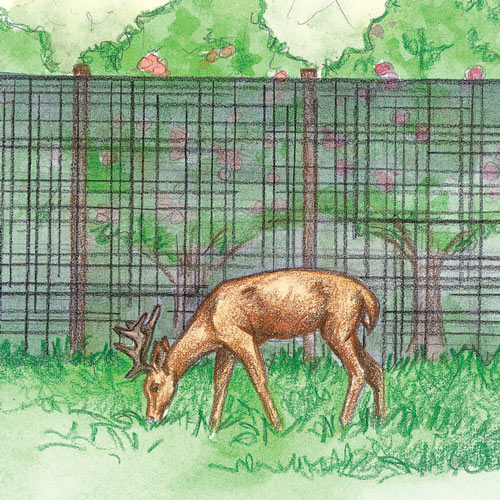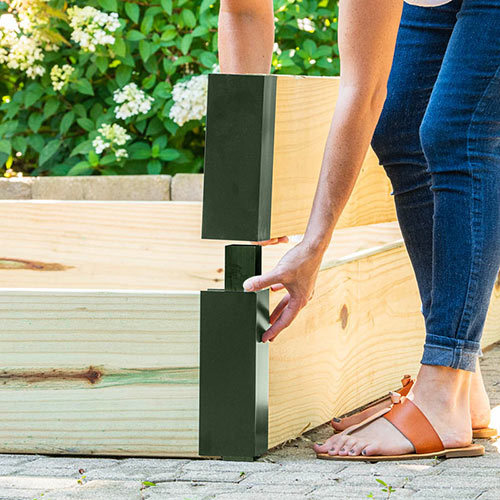Deer, Evil Squirrels, Cartoon Dice, Killing a Lawn Softly and Explaining Endorphins
-
Helpful Products from Gardens Alive!
-
 Deer Stop Garden Netting
Deer Stop Garden Netting -
 Raised Garden Bed Corners & Extenders
Raised Garden Bed Corners & Extenders
The wait is almost over! New episodes of YBYG (our 26th season!) begin on September 13th from NPR station WDIY-FM in Allentown!-
Q. Daniel writes "My wife and I listen to your podcast and are 'just ducky' in Sanatoga PA, just east of Pottstown.
Deer are an issue here as they can't be hunted near homes. I was hoping you could tell us which motion activated sprinkler you would recommend to repel deer, other critters and of course "Satan's Evil Servants", the squirrels. We are planting three raised beds, each 12 inches high, 13 inches wide and 11 inches long side by side with a 36-inch space between each. Would a sprinkler be enough, or should we also use a (pain to install) fence?"
A. Those are small beds. Not sure of the terrain you're working with but I see no reason for three-foot wide lanes; the standard is two feet. So feel free to shrink the lanes and expand the beds a bit.
That said, a motion-activated sprinkler should be perfect to protect an area that size. I really can't endorse a specific brand but I can suggest you visit the land of Amazonia and read the reviews.
Oh, and while it is getting late in the season to get started, I still think it's a good idea to build the beds now. Then you can grow a lot of cool season crops like lettuce, spinach, kale and beets. And be sure to save one of the beds for a big planting of garlic, which in your area (where the climate is similar to the Philadelphia suburbs), should be planted around September 1st. If you're going to mail order the planting garlic, get the order in now, as the rush for plants and supplies this season has not decreased in the least. Or talk to the folks at your local farmer's market and see if you can reserve some; they'll be harvesting this year's crop VERY soon.
Q. Nancy in Flourtown, PA writes: "I found a colony of tiny black bugs with white dots on my roses. I instinctively squashed them with a gloved hand but did not think to get a picture first. I could not id them on Google. I'm hoping they were not beneficial. Can you help me with this? PS: It's great to see your handsome face on TV on pbs39!"
A.Thank you, but I think you may need new glasses.
Anyway, those crazy black and white cartoon dice with legs are the nymph form of our newest invasive enemy, the Spotted Lantern Fly. Don't feel bad; I didn't know what they were when they showed up (interestingly enough on my roses as well) last season. Because I didn't know what they were, I did nothing and they did no damage I could see. Spray them off with sharp streams of water early in the morning or soak them with insecticidal soap or a light horticultural oil designed for use in the summer.
Update! This just in! Penn State has devised a new trap for these imported pests that doesn't pose a threat to birds, bees and bats like the previously recommended sticky traps. This trap is so new I couldn't find any info on it at the Penn State website.
Q. Judy in South Central PA (who listens to us Sundays on WPSU, our Penn State affiliate) writes: "I'm looking for an easy way to create space for a garden. What would you think about covering a portion of grass with black plastic? Would it kill the grass? Would it be easier than digging up the grass? Any other suggestions?"
A. You will have nothing but misery if you attempt to kill a portion of a lawn and then try and grow a flat earth garden there. It would take years to do the initial job well in your climate, and then the grass would quickly move back in.
But success will follow if you scalp that area of lawn until dirt blows out the back of the mower, lay down a single sheet of thick cardboard over top and then top that with a nice raised bed frame that you will fill with a mix of high-quality compost, screened topsoil and lots of perlite. Then, as we just mentioned, you can plant fall crops in it right away and be ready to hit the ground running at full speed next season. Remember to keep the width at or under four feet, but make it as long as you like.
Q. Margaret in Hampton Virginia writes: Can you give me a reference for a show that aired several weeks ago? You and the guest were having a discussion about how the smell of good soil increases ones' levels of endorphins."
A. Absolutely; but first I have to apologize to our guest that day, Suzanne Longacre, who was supposed to discuss something completely different (companion planting), but she talked about that research while we were getting ready and then I blindsided her by turning the whole interview into a discussion of this fascinating phenomena.
Anyway, we got a lot of requests for the original study, but my research found that the information came from several studies that had been combined to make numerous articles in the 'popular' press; which is only to say that these compilations have not been peer reviewed, but they are well written and researched. We'll post links to a number of them with this week's article at the Gurney's website.
They're all a little bit different, and all contain links to some of the original peer-reviewed studies....
https://qz.com/993258/dirt-has-a-microbiome-and-it-may-double-as-an-antidepressant/
https://www.gardeningknowhow.com/garden-how-to/soil-fertilizers/antidepressant-microbes-soil.htm
https://permaculture.com.au/why-gardening-makes-you-happy-and-cures-depression/
https://www.medicalnewstoday.com/articles/66840#1
-
Helpful Products from Gardens Alive!
-
 Deer Stop Garden Netting
Deer Stop Garden Netting -
 Raised Garden Bed Corners & Extenders
Raised Garden Bed Corners & Extenders







 Gardens Alive! & Supplies
Gardens Alive! & Supplies




